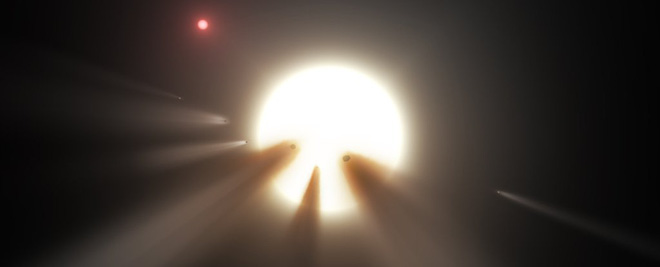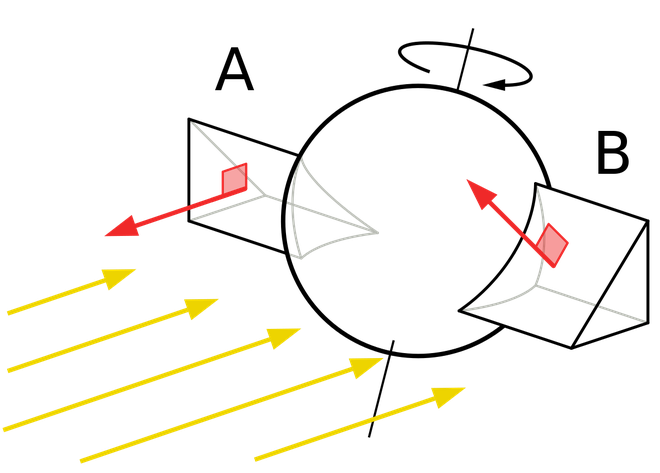About 6 billion years from now, the light from the dying Sun will burn the asteroid belt
New research shows that the light from a dying star is so strong it can turn asteroids into dust. This is what happens to almost every existing star in the Universe, including our dear Sun. Approximately 5-6 billion years from now, when the central star of the Solar System dies, it will burn the asteroid belt between Mars and Jupiter.

The only agent of mass destruction is electromagnetic radiation. According to the experimental model, the YORP effect (Yarkovsky-O'Keefe-Radzievskii-Paddack, derived from the names of the four scientists who contributed to its discovery) will be the main role in the process. The YORP effect occurs when the heat of a star changes the rotation of a small object in the Solar System - such as an asteroid.

The light emitted from "B" fins is about the same size as "A" fins, but not parallel to the incident light. This creates a torque on the asteroid.
Asteroids will be heated by the light energy emitted by the Sun. Heat propagates in the rock until it radiates in different directions as heat radiation.
The heat generated from the meteorite will create a small thrust; The thrust effect will not be noticeable in a short amount of time but if the heat generation is continuous, it can cause an asteroid to spin in midair or wobble off its inherent axis of movement. Today, through the phenomenon of "rolling asteroids" we can observe this process. And as the Sun progresses into subsequent evolutionary cycles, the effect will become even more pronounced.
When the stars or the Sun are at the end of an evolutionary sequence, they enter a giant phase and expand, becoming very large and bright. That phase only lasted a few million years, after which it pushed its outer matter into space and collapsed into white dwarfs - a dead star with a dense density of matter.
About 5-6 billion years, if not migrated to other places, humanity will see this phenomenon firsthand.

The sun becomes a red giant.
" When a typical star reaches its massive phase, its brightness reaches a maximum of 1,000 to 10,000 times the brightness of our Sun ," explains astrophysicist Dimitri Veras of the University of Warwick.
" After that, the star shrinks to a white dwarf of the same size as Earth very quickly, where its brightness drops below the Sun. So the YORP effect is only important during the giant period, but almost nonexistent after the star becomes a white dwarf . "
As the initial brightness increases, the YORP effect will also increase. Because asteroids originate from countless pieces of rock gathered by gravity, most asteroids do not have dense material densities, so when subjected to the YORP effect, they will start to become more lax.
According to the model running on the computer, the YORP effect will cause most asteroids larger than 200 meters to start rotating, enough to cause them to disintegrate. Stable structures will be safe, but the asteroid belt we still know will face the future, though bright but not very bright.
" The YORP effect is very intense and fast, will last for a million years. Our asteroid belt will not only be destroyed, but it will be quickly and brutally destroyed. The only factor causing this is light from the Sun itself, "said the Veras researcher.
It is not just computer simulations that show evidence of this. Veras' observations of white dwarfs also show this.
More than a quarter of white dwarfs have metal traces from the asteroid's core in their spectrum. Asteroids' traces in the white dwarf spectrum are a mystery, and are still under debate. The YORP effect may be the reason for this strange thing. When the asteroids crumble under the power of a dying star's light, they form a disk of asteroid dust orbiting, the rest will be attracted to the white dwarf star.

A white dwarf star.
" These results help locate debris in the 'white dwarf system' and the giant branch, thereby observing how white dwarfs get physical debris from outer space ," Veras concluded.
" We need to know why debris appears at the moment a star becomes a white dwarf to understand how dust disks are formed. So the YORP effect will provide an important model to identify. the source of those fragments ".
The research was published in the Monthly Notices of the Royal Astronomical Society .
You should read it
- 10 tips to prevent computer radiation, laptops help protect health
- Smartphones emit the highest and lowest electromagnetic radiation today
- NASA will shoot asteroids close to Earth
- The strange object is both a double asteroid and a comet in the Solar System that confuses astronomers
- 8 types of plants that resist ultra-good electromagnetic radiation for those who regularly use computers
- The best solar system simulation software
- What is the radiation emission level on iPhone 7 exceeding the limit?
- The great mystery of the Solar System has just been unlocked
May be interested
- The asteroid is similar in size to the Pyramids of Giza, and is likely to crash into Earth on May 6, 2022
 the asteroid is called jf1 and nasa scientists predict that it will be in contact with earth on may 6, 2022.
the asteroid is called jf1 and nasa scientists predict that it will be in contact with earth on may 6, 2022. - New technology stores data for 1 billion years
 researchers demonstrated a type of storage memory using carbon nanotubes with the ability to store up to 1 trillion bits per square inch over a period of 1 billion years.
researchers demonstrated a type of storage memory using carbon nanotubes with the ability to store up to 1 trillion bits per square inch over a period of 1 billion years. - How to Burn a CD on Mac OS X
 mac os x allows you to burn cds without installing any special software. you can burn data onto cds to store files in large quantities, or audio discs to play music on a sound system, or you can burn images from other discs onto cds. follow these instructions to learn how to burn discs quickly and accurately.
mac os x allows you to burn cds without installing any special software. you can burn data onto cds to store files in large quantities, or audio discs to play music on a sound system, or you can burn images from other discs onto cds. follow these instructions to learn how to burn discs quickly and accurately. - Discovering new gravitational waves from two black holes collides 3 billion light-years away
 new gravitational wave signals are produced when two black holes are 3 billion light-years away facing each other and eventually merging into a new one discovered by german scientists in the early morning of january 4.
new gravitational wave signals are produced when two black holes are 3 billion light-years away facing each other and eventually merging into a new one discovered by german scientists in the early morning of january 4. - What is the light year?
 the unit of light years is often used when referring to the distance in the universe as the distance from the earth to the sun, moon, mars or the distance between planets ... so, the light year is what? how many kilometers is a light year?
the unit of light years is often used when referring to the distance in the universe as the distance from the earth to the sun, moon, mars or the distance between planets ... so, the light year is what? how many kilometers is a light year? - How to Burn a CD Using Mac OS X
 mac os x allows you to burn, or write, cds without installing any special software. you can burn data cds to store large amounts of files, audio cds to play in a stereo, or you can burn images of other discs to a cd. follow this guide to...
mac os x allows you to burn, or write, cds without installing any special software. you can burn data cds to store large amounts of files, audio cds to play in a stereo, or you can burn images of other discs to a cd. follow this guide to... - How bad is the Earth after 1 billion years?
 after a billion years, the earth will have an average temperature of 47 degrees celsius, no more eclipses will appear, 99% of the trees will disappear, the oceans will completely evaporate, most organisms living will be exterminated.
after a billion years, the earth will have an average temperature of 47 degrees celsius, no more eclipses will appear, 99% of the trees will disappear, the oceans will completely evaporate, most organisms living will be exterminated. - How to Burn Songs on to a CD
 this wikihow teaches you how to burn song files, such as mp3s, onto a blank cd. if you want to be able to play the songs off of the cd, you'll need to burn the cd using itunes or windows media player. you can also burn music files (along...
this wikihow teaches you how to burn song files, such as mp3s, onto a blank cd. if you want to be able to play the songs off of the cd, you'll need to burn the cd using itunes or windows media player. you can also burn music files (along... - 3 Good postpartum abdomen belts get back to a slim waist
 made from high quality materials, cheap resale prices, top 3 models of lower belly belts are chosen by many women to regain shape after birth.
made from high quality materials, cheap resale prices, top 3 models of lower belly belts are chosen by many women to regain shape after birth. - How to Burn MP4 to DVD
 this wikihow teaches how to burn an mp4 video file onto a blank dvd disc. in order to make a dvd playable in most dvd players, you'll need to use free software such as dvd flick (windows) or burn (mac). if you just want to store the mp4 or...
this wikihow teaches how to burn an mp4 video file onto a blank dvd disc. in order to make a dvd playable in most dvd players, you'll need to use free software such as dvd flick (windows) or burn (mac). if you just want to store the mp4 or...










 Bill Gates: Artificial intelligence and gene editing technology will save humanity
Bill Gates: Artificial intelligence and gene editing technology will save humanity Breakthrough: The first discovery of an oxygen molecule outside the Milky Way
Breakthrough: The first discovery of an oxygen molecule outside the Milky Way In the future, scientists will use crystals to encode information
In the future, scientists will use crystals to encode information Discovered 'hidden bomb' in the soil: industrial chemicals have the ability to affect the immune system and fertility in humans
Discovered 'hidden bomb' in the soil: industrial chemicals have the ability to affect the immune system and fertility in humans Learn about the capabilities of Avenger called Hyperion - the Marvel version of Superman
Learn about the capabilities of Avenger called Hyperion - the Marvel version of Superman Before 'returning to Thanos', what was the fate and appearance of Nebula in the comics?
Before 'returning to Thanos', what was the fate and appearance of Nebula in the comics?